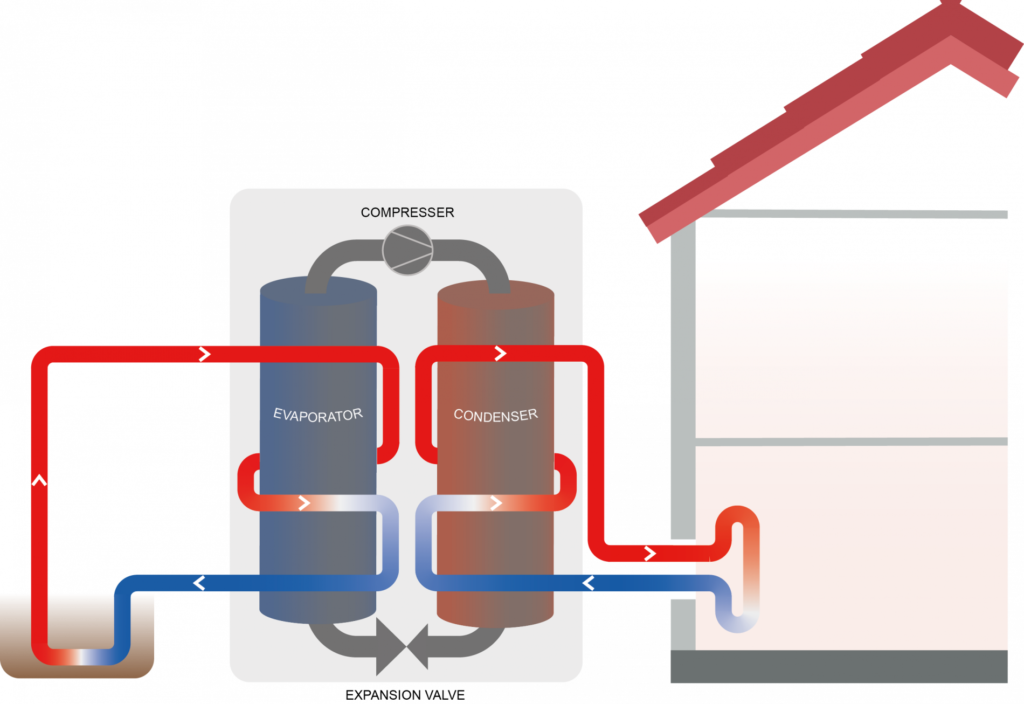How does a heat pump work_ A heat pump is a device used to warm and cool buildings by transferring thermal energy from a cooler location to a warmer space using the refrigeration thermodynamic cycle in the opposite direction in which regular heat transfer would occur without any external power? Standard device models include ground-source heat pumps, air-source heat pumps, water source heat pumps, and exhaust air heat pumps. Heat pumps are also often utilized in district heating operations.
The efficiency of a heat pump is displayed as the Seasonal Coefficient Of Performance (SCOP) or the Coefficient Of Performance (COP). A heat pump is more efficient because they have a higher COP number and consume less energy. These devices are typically much more energy-efficient than simple electrical resistance heaters when used for space heating. Heat pumps have a less carbon footprint compared to heating systems burning fossil fuels, the same as natural gas.
⇒ View a Comprehensive List of Heat Pumps for Sale and Their Suppliers ⇐
How Does a Heat Pump Work?
Vapor-compression has a circulating liquid refrigerant as the medium that dissipates heat from one zone and compresses it, raising its temperature before releasing it in a different space. The system has typically eight main parts: a reservoir, a compressor, a reversing valve that chooses between cooling and heating mode, two thermal expansion valves (one for heating mode and the other for cooling mode), and two heat exchangers (one connected with the external heat source/sink and another with the interior). In heating mode, the internal one is the condenser, and the external heat exchanger is the evaporator; in a cooling way, the roles are changed.
Circulating refrigerant inserts the compressor in the thermodynamic phase known as a saturated vapor and is compressed to a higher pressure, ending in higher temperatures as well. The hot, compressed vapor is in the thermodynamic state recognized as a superheated vapor. It can be condensed with either cooling water or cooling air flowing across the coil or tubes at that temperature and pressure. In heating mode, this energy is used to heat the building with the internal heat exchanger, and in cooling form, this energy is rejected by the external heat exchanger.
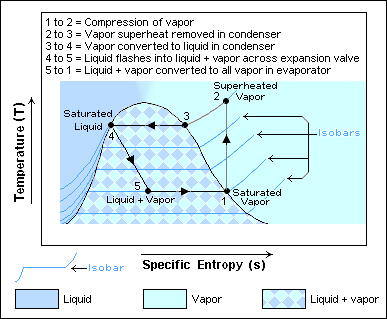
The condensed liquid refrigerant is in the saturated liquid thermodynamic state and is routed through an expansion valve. So, it undergoes an abrupt reduction in pressure. This pressure reduction is adiabatic flash evaporation of a part of the liquid refrigerant. The auto-refrigeration impact of the adiabatic flash evaporation reduces the temperature of the vapor and liquid refrigerant mixture to reach the point it is colder than the temperature of the surrounding space to be refrigerated.
The cold flow is then routed into the coil or tubes in the evaporator. A fan flows the warm air in the confined space across the coil or lines carrying the cold refrigerant vapor and liquid mixture. That warm air evaporates the liquid portion of the cold refrigerant mixture.
Simultaneously, the circulating air is moderated and thus lowers the surrounding space’s temperature to the desired temperature. The evaporator is the part where the circulating refrigerant absorbs and removes the energy, which is finally rejected in the condenser and transferred elsewhere by the air or water used in the condenser. To complete the refrigeration cycle, the refrigerant vapor from the evaporator is again saturated vapor and is routed back into the compressor.
Ice or water may accumulate in the evaporator due to ambient humidity over time. The ice is melted by using a defrosting cycle. An internal heat exchanger is either worked to heat/cool the inside air directly or to heat water that is then traveled through radiators or underfloor heating circuits to either cool or heat the buildings.
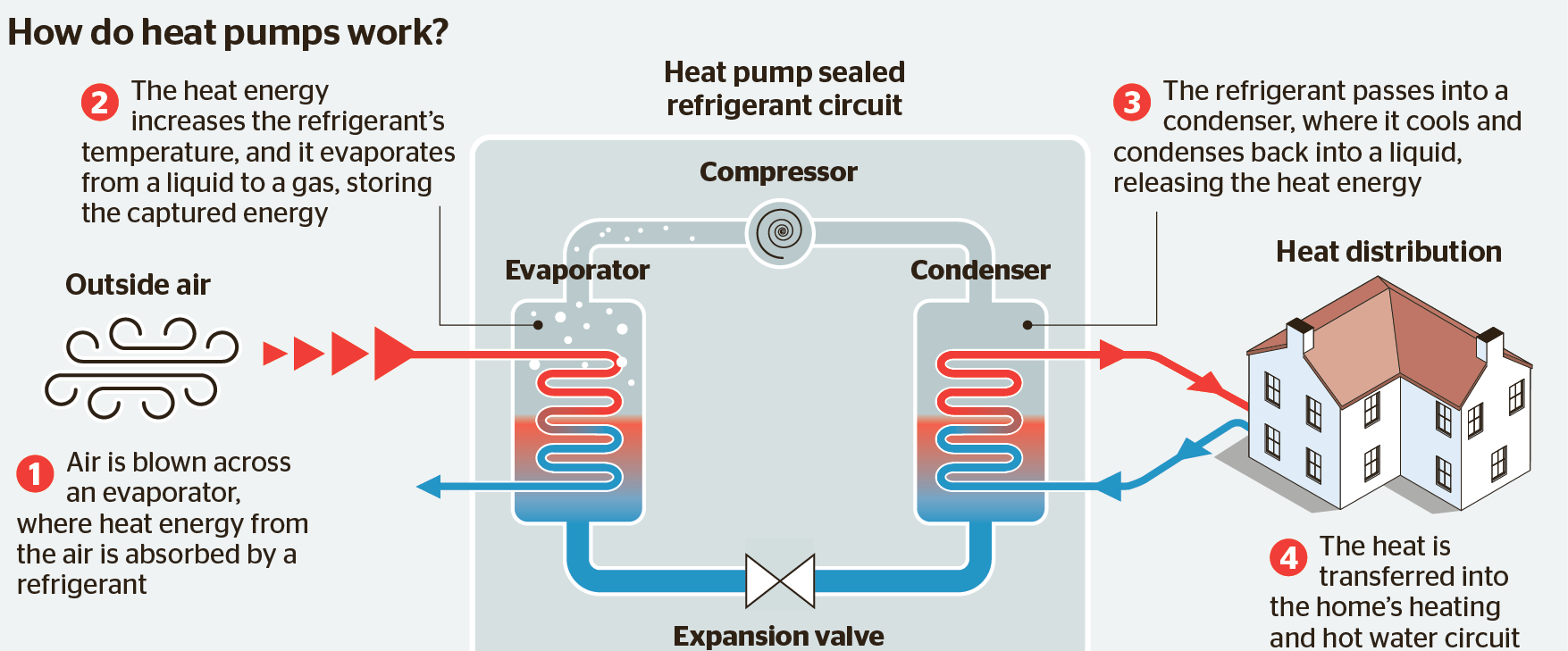
Types of Heat Pumps
Typical types of heat pumps are ground-source heat pumps, air-source heat pumps, water source heat pumps, Solar-assisted heat pumps, exhaust air heat pumps, and hybrid heat pumps.
Air Source Heat Pump
Air source heat pumps move heat between two heat exchangers, one outside the house fitted with fins, and the air is forced using a fan. The other either directly heat the inside air or heats water which is then circulated in the building through heat emitters releasing heat in the building. These devices can also work in a cooling form where they extract heat through the inner heat exchanger and remove it into the ambient air using the outer heat exchanger. They are regularly applied for washing applications, stored in a domestic hot water container.
Air source heat pumps are comparatively easy and inexpensive to install and have been the most extensively used heat pump type. In moderate weather, COP may reach nearly 4.0, while at temperatures beneath 0 °C (32 °F), an air-source heat pump may still have a COP of 2.5. The common COP over seasonal change is typically 2.5-2.8.
Geothermal (Ground-Source) Heat Pump
Geothermal heat pumps or ground-source heat pumps draw heat from the soil or groundwater, which are at a relatively constant temperature all year below a depth of about 9.1 m (30 feet). A well prepared geothermal heat pump typically has a COP of 4.0 at the start of the heating season, and a seasonal COP of approximately 3.0 as heat is extracted from the ground.
Geothermal heat pumps are more expensive to establish the drilling of boreholes for vertical installation of heat exchanger piping or digging channels for the horizontal arrangement of the piping that carries the heat exchange liquid (water with a bit of antifreeze). We can use a geothermal heat pump to cool homes during hot days, carrying heat from the dwelling back into the ground via the ground loop.
Exhaust Air Heat Pump
Exhaust air heat pumps obtain heat from the exhaust air of a structure and need mechanical ventilation. There are two types of exhaust air heat pumps.
- Exhaust air-water heat pumps transfer heat to a heating line that involves a tank of domestic hot water.
- Exhaust air-air heat pumps transfer heat to intake air.
Solar-Assisted Heat Pump
A solar-assisted heat pump is a device that represents the combination of thermal solar panels and a heat pump in a single integrated scheme. Typically two presented technologies are used individually (or are performed in parallel) to produce hot water. In this system, the solar thermal panel serves the function of the low-temperature heat source, and the generated heat is used to supply the heat pump’s evaporator. This system aims to get high COP and then provide energy more efficiently and less expensively.
Water Source Heat Pump
A water-source heat pump operates similarly to a ground-source heat pump, except that it uses heat from a body of water instead of the ground. The body of water should be large enough to withstand the cooling result of the unit without freezing or creating an unfavorable effect on wildlife.
Hybrid Heat Pump
Hybrid (or twin source) heat pumps extract heat from various sources depending on the outdoor air temperature. They use air when the outside air is above 4 to 8 degrees Celsius (40–50 degrees Fahrenheit, based on the groundwater temperature), while at colder temperatures, they use the ground source.
These double source systems can also save summer heat by operating ground source water through the air exchanger or the construction heater-exchanger, even if the heat pump is not running. This has two benefits: it works in a low-cost system for inside air cooling, and (if groundwater is comparatively stagnant) it raises the temperature of the ground source, which increases the energy efficiency of the heat pump system by approximately 4% for every degree in a temperature rise of the ground source.
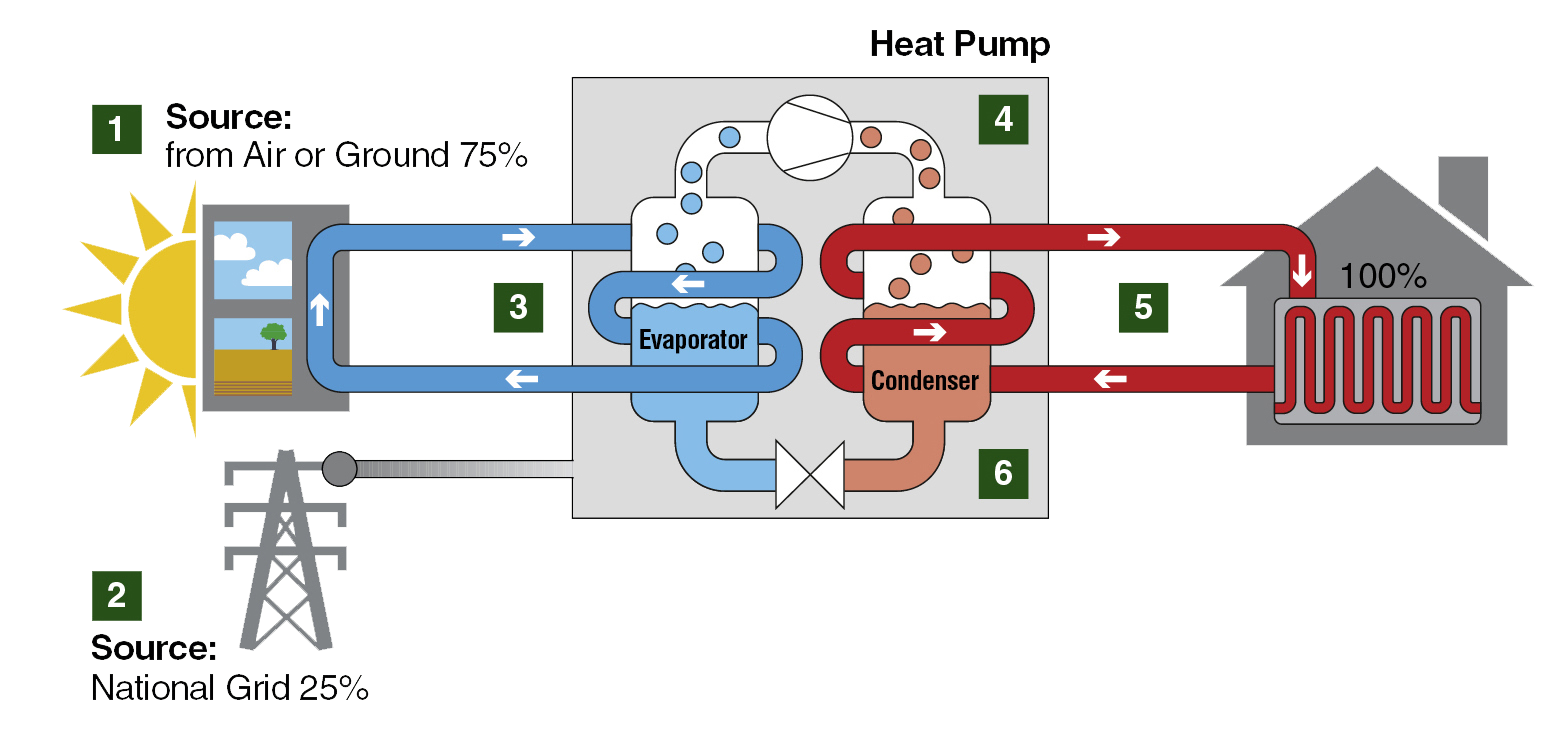
Refrigerant Choice
Before the 1990s, heat pumps, fridges, and other related products used chlorofluorocarbons (CFCs) as working fluids and refrigerants that caused major destruction to the ozone layer when discharged into the atmosphere. The use of these chemicals was forbidden or seriously restricted by the Montreal Protocol of August 1987.
Some replacements, including R-410A and R-134a, are hydrofluorocarbon with related thermodynamic properties with less ozone depletion potential but had doubtful global warming potential. HFC is a potent greenhouse gas that contributes to climate change. More recent refrigerators are isobutane (R600A) and difluoromethane (R32), which do not consume the ozone and are also far less dangerous to the environment. The application of Dimethyl ether (DME) has also grown as a refrigerant.
Applications
There are millions of residential installations utilizing air source heat pumps. They are used in moderate climates for heating and cooling needs (HVAC) and may also provide household hot water and tumble clothes drying purposes.
Heating and Cooling of Buildings and Vehicles
In ventilation, heating, and air conditioning (HVAC) applications, a heat pump is typically a piece of vapour-compression refrigeration equipment that has optimized heat exchangers and a reversing valve so that the direction of heat flow (thermal energy) may be changed. The reversing valve shifts the direction of the refrigerant by the cycle, and therefore the heat pump may produce either heating or cooling in a home. In cooler climates, the standard setting of the reversing valve is heating while the default setting in warmer temperatures is cooling. Because the condenser, the two heat exchangers, and the evaporator must swap roles, they are optimized to function adequately in both forms. Consequently, the Seasonal energy efficiency ratio (SEER) rating of a reversible heat pump is typically slightly less than two independently optimized machines.
Water Heating
A heat pump may be used in water heating applications to preheat or heat water for swimming pools or heat drinking water for use by residences and industries. Usually, heat is obtained from the outside air and transferred to an indoor water container. Another type extracts heat from indoor air to help in cooling the space.
District Heating
Heat pumps can also be utilized as heat suppliers for region heating. Potential heat sources for such purposes are sewage water, industrial waste heat, geothermal energy, ambient water (e.g. sea, lake, and river water), flue gas, heat from solar heat storage, and waste heat from district cooling. In Europe, more than 1500 MW have been established since the 1980s. Nearly 1000 MW of this energy was in use in Sweden in 2017. Large scale heat pumps for area heating coupled with thermal energy storage offer great flexibility for integrating variable renewable energy. As a result, they are considered a key technology for intelligent energy systems with up to 100% renewable energy share and advanced 4th generation district heating systems. They are also a critical part of cold district heating systems.
Industrial Heating
There is a high potential to decrease energy consumption and associated greenhouse gas emissions in the industry by applying industrial heat pumps. An international collaboration project developed in 2015 collected a total of 39 examples of R&D projects and 115 case studies. The study reveals that short payback periods are probable (less than two years), and a high decrease in CO2 emissions can be reached (more than 50% in some examples).
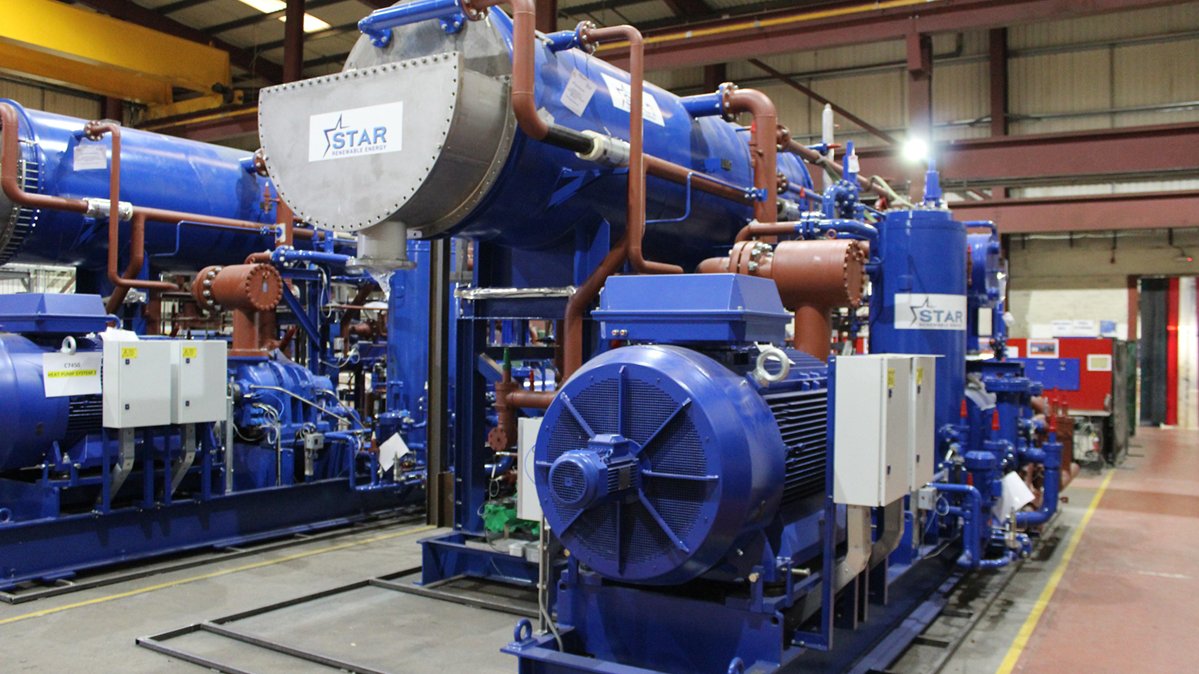
Buy Equipment or Ask for a Service
By using Linquip RFQ Service, you can expect to receive quotations from various suppliers across multiple industries and regions.
Click Here to Request a Quotation From Suppliers and Service Providers
Read More on Linquip
- What is Heat Pump & How Does it Work?
- Working Principle of a Centrifugal Pump
- Heat Pump Efficiency: Types and Equations
- Hydraulic Pump Working Principles: Ultimate Guide
- 16 Parts of Heat Pump and Functions (Clear Guide)
- What Is a Demand Pump and How Does It Work? (Clear Guide)
- Understanding Heat Pumps in Winter: How Do They Work?

